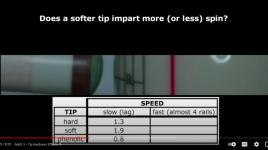You can easily prove it to yourself, if so.I'll repeat to you the same observation made by others in this thread: If you hit the same spot on the CB, you will not get the same spin/speed ratio with a hard break tip as with a soft tip...especially at low speed.
Apples and oranges, but I think you're wrong about this too.Try playing a soft massé in straight rail with a hard break tip, for example. I don't care how delicate your stroke is, not even Frédéric Caudron can execute that with a hard break tip.
pj
chgo
